What is a dye sublimation printer and how to choose one?

Recently, the application of images on clothes, dishes, hats and souvenirs has become quite popular. This procedure is quite simple and available to everyone who has at least minimal skills in using office equipment. To transfer drawings to fabric, metal, glass and plastic, a special sublimation printer is used - a device that provides high-quality photo printing on any hard surfaces.


What it is?
Sublimation printer fundamentally different from inkjet and laser counterparts and has a completely different principle of applying paint to an object. And if inkjet models are printed with liquid ink, and laser models - with dry powder, then sublimation samples use special tapes for printing, resembling cellophane, with dyes of several colors applied to them.
Today, in addition to monochrome cartridges equipped with white and black ribbons, there are three-color models, consisting of cyan, yellow and magenta colors, four-color, where black is added to the existing shades, and multi-color, having 6 or more colors. Printhead such printers are equipped with a heating element, under the influence of which the ink passes from a solid state into a gaseous phase, bypassing the liquid one. This process is called sublimation, and printers that work on this technology began to be called sublimation ones.


The principle of operation of the sublimation printer is quite simple and looks like this: inside the machine there are 2 rollers - receiving and feeding, which, when the command "Print" starts to rotate and rewind the tape. The colorants on this tape pass through the heating element and mix in the gaseous cloud in the required proportions by means of a special diaphragm. The diaphragm, in turn, also acts as a kind of filter, filtering out unnecessary vapors.
In this case, the color mixing does not take place on paper, as in other types of printers, but in a gaseous cloud inside the device. When the temperature of the heating element rises to 2000 degrees, the image becomes more saturated, which is due to the expansion of the pores of the working material and deeper penetration of the dye inside.
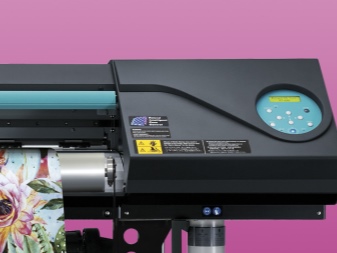
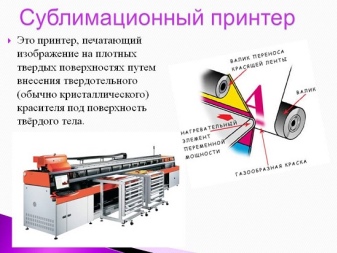
And vice versa - if necessary, to obtain delicate muted shades and light colors, the heating temperature is lowered.
Most sublimation models work in a resolution of no more than 300 dpi, however, thanks to the technology of gaseous mixing of dyes the colors are very rich and realistic. This allows you to print images of any brightness without losing color when transferring to the product. Moreover, sublimation printing is free from such disadvantages as banding and screening, which are most typical for inkjet printers. Images printed on such a printer are not subject to fading, since the ink is not located on the surface of the working material, but, as it were, is soldered into its structure.
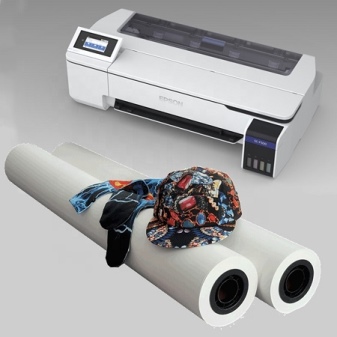
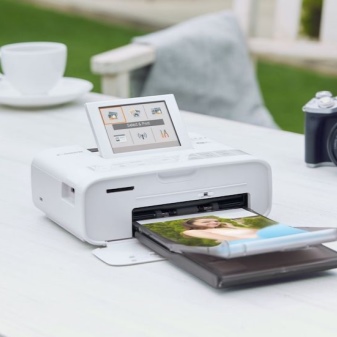
Advantages and disadvantages
The high consumer demand for dye-sublimation printers is due to a number of their undeniable advantages over inkjet and laser designs.
- Due to the penetration of paint deep into the working surface, the image is very resistant to abrasion.For example, clothes with a sublimation pattern can be machine washed in normal modes, and dishes with sublimation patterns can be safely cleaned with abrasive products.
- Due to the gaseous mixing of paints, sublimation allows you to get a higher picture quality at a low resolution of the device. This is one of the main advantages of sublimation samples over laser and inkjet models.
- Most modern devices are equipped with liquid crystal displays, which allows you to display and correct the working information before transferring the image to the working surfaces.
- Printers are capable of handling a wide variety of materials such as paper, cardboard, cloth, glass, plastic and metal. This allows them to be used in the manufacture of clothing, in the advertising business, as well as in the manufacture of gift and souvenir products.
In addition to the obvious advantages, sublimation printers still have disadvantages. These include high cost the units themselves and their consumables, and also quite slow photo printing.
In addition, sublimation inks are vulnerable to UV rays and require special protective additives to prevent fast image fading.


What is it needed for?
The scope of use of sublimation printers is quite wide. Such models can be seen in photo workshops, printing houses and withAlonah for the manufacture of souvenir products. With their help, you can apply images to mugs, plates, T-shirts, plastic badges and caps, as well as make advertising brochures, business cards, certificates of honor, sports pennants, posters and plastic cards. In addition, sublimation is used to apply logos to ballpoint pens, souvenirs and key rings, as well as to produce cabinet signs and gift nameplates.
There are two types of sublimation - direct and transfer.
- In the first case, printing is carried out directly on the product - plastic or paper, and in the second - on a special siliconized sheet in a mirror image, and only then is transferred to the object using a heat press.
- In the first way, logos are placed on plastic products and plastic cards, and in the second, they decorate clothes, make door plates and wardrobe numbers, and also apply drawings to glass and ceramic dishes, metal flasks, lighters and cigarette cases.


However, it should be noted that not all materials are suitable for sublimation printing. These materials include natural leather and wood. Natural fabrics, without the addition of synthetics, are also suitable for sublimation with great restrictions, on which the sublimation dye does not last very long. A way out of the situation can be the use of a special primer, which is applied directly to the material before transferring the image to the product.
In terms of size, using a sublimation printer the application of the image of the most different size is possible. The most popular sublimation paper sizes are A4, used for printing on T-shirts, bags and towels, A3 for drawings the size of a notebook sheet, and A2 for printing posters, flags and posters. The sublimation printer is also suitable for large-format printing (special plotters are used for this), as well as for working on natural stone.
It should be noted that working on minerals requires preliminary surface treatment with a special polymer.


Species overview
The modern office equipment market for home and office offers sublimation printers in a wide range. In terms of functionality and work resource, all available equipment can be divided into amateur and professional.
Professional
Professional equipment includes printers for photo workshops, advertising agencies and salons for the production of printed and souvenir products. As a rule, it is high-tech, multifunctional, often floor devices, the price of which can be very high. But despite the impressive cost, due to the large number of manufactured products, the cost of each image is quite low, and an expensive purchase quickly pays off.


Amateur
Household desktop models, although they differ in lower cost in comparison with professional samples, however, the cost of one image will still be quite high. Therefore, for home use, sublimation models are not purchased too often, preferring laser or inkjet samples.
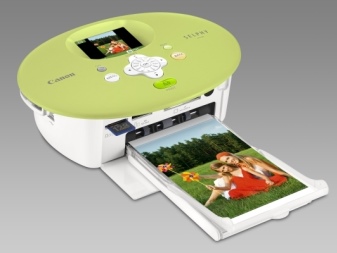

Popular models
Today, the leaders in the production of sublimation printers are the companies Canon, Mitsubishi, Epson, Sony and DNP. At the same time, Sony specializes in home desktop models, while Canon and Epson have both household and professional models.
- Colored sublimation Canon Selphy CP1300 photo printer has a resolution of 300x300 dpi, can work with A6 format and is equipped with Wi-Fi and USB type B. The device allows you to quickly create high-quality photographs from digital media, smartphones and cameras. The model has a large number of necessary layouts and options for arranging photographs, including the function of "photo for documents". The images are resistant to environmental influences and are characterized by high contrast and rich colors. The printer has an average print speed and is able to output a 10x15 cm image in just 47 seconds. The model is equipped with a 3.2-inch TFT touch-type display and costs about 9,000 rubles.

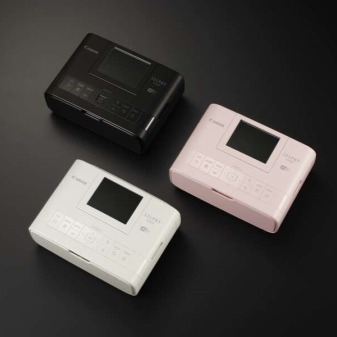
- DNP Model DS-RX1 has a resolution of 600x300 dpi, data transfer from external sources is carried out via USB type B, the maximum possible format is A6. The printer does not have a display, it is produced in dimensions 32.2x35.1x28.1 cm, weighs 14 kg and costs 45,000 rubles.

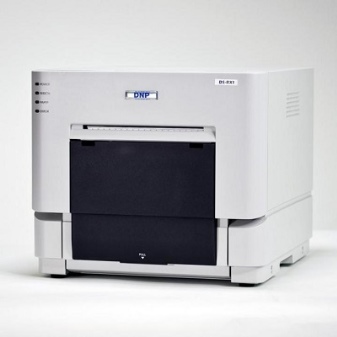
- Mitsubishi Model CP-D80DW with a resolution of 300x300 dpi, it is designed for printing on roll paper, connects to a computer via USB type B, does not have a screen and is equipped with 64 MB of RAM. The printer is designed for the A6 size and is well suited for printing photographs. The model has good speed and is capable of printing a 10x15 cm photo in 11.3 seconds. At the same time, it takes only 8.3 seconds to print a 5x15 cm format, and 21.5 seconds to create a 15x20 cm photo. The cost of the unit is 45,000 rubles.


- Epson SureColor SC-F6200 Printer designed for printing on clothing and souvenirs and will be ideal for small private workshops. The model is equipped with a built-in disc cutter and refillable ink tanks. The device is equipped with a shaftless roll holder and is capable of printing on sublimation paper up to 111.7 cm wide, while developing a speed of up to 63.4 m2 / h. The printer kit includes packages of 1 liter ink, the cost of the device is 543,000 rubles.


- Sony DPP-FP90 Desktop Sublimation Photo Printer equipped with a memory card reader, has a 3.6-inch LCD display and support for the Windows operating system. The model is three-color, can print without borders and works at a resolution of 300x300 dpi. The print speed of a 10x15 cm photo is 45 seconds, and the weight of the model is only 1.2 kg.
The printer is notable for its small size and lack of noise during printing, and the main disadvantage is the lack of consumables.

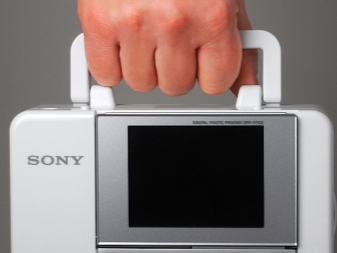
How to choose?
There are a number of important points to consider when choosing a dye sublimation printer.
- Particular attention should be paid to the number of colors. So, if the printer is purchased for the home, then you can limit yourself to the three-lane option. If the technique is chosen for entrepreneurial activities involving the mass production of souvenirs or clothing, then it is better to buy a four- or six-lane sample.
- And you also need to look at the minimum drop volume, which is measured in picoliters (pl). The lower this indicator, the more clear and expressive the picture will be.The ideal option would be to buy a printer with a drop size of 1.5 pl. However, this choice has a downside: the print head of such models clogs up much more often than, for example, devices with a droplet size of 4 pl.
- If the printer is bought for advertising agencies or printing houses, then you need to choose a large-format floor model capable of printing banners and posters. For home use, a miniature desktop model will be enough: they take up little space, work almost silently and are much cheaper than professional samples.
- A significant point is the presence of a continuous ink supply system (CISS).
In such models, the ink is not in a cartridge, but in large cans, which allows the printer to be refilled much less often.
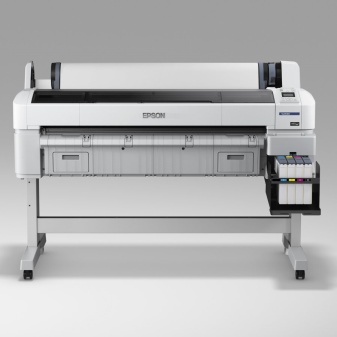

For how the sublimation printer works, see the next video.













The comment was sent successfully.